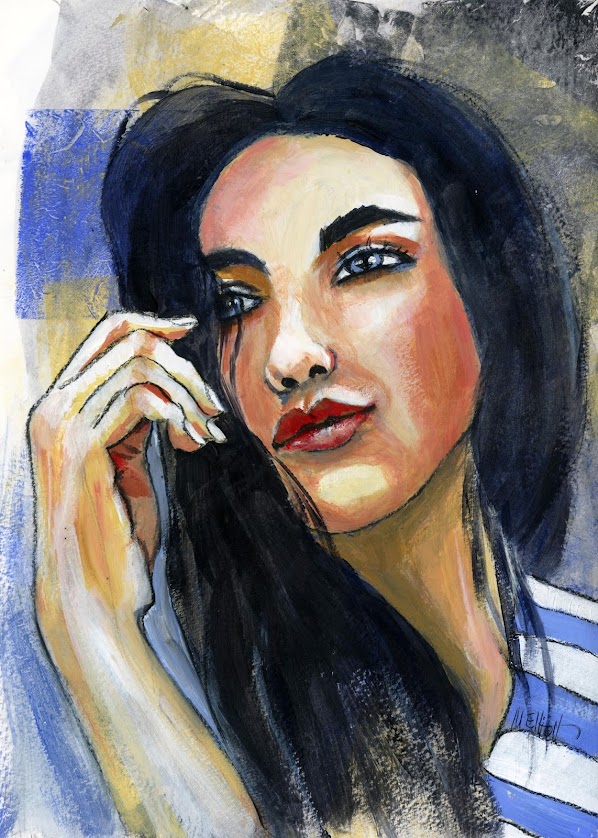I didn't initially plan to do this week's lesson for Let's Face It 2021 with Jenny Manno, for several reasons: First, she was doing the whole thing using pan pastels, and I neither own them nor wish to acquire facility with yet another medium—moving from watercolors to acrylics is plenty right now, thanks! and second, I feel inundated by the wide-faced, big-eyed, button-nosed, luscious-lipped, long-necked baby doll girls that are a Manno trademark. Don't get me wrong—they obviously have their appeal—but Jenny has such a huge following who all do her three weekly challenges that my Facebook feed is overwhelmed with them. Finally, my goal as a portraitist is always to find a likeness.
It's interesting to me that Emma Petitt, whose work I am currently following, also shies away from trying to capture a specific likeness in favor of making a more universal female image; Emma still accentuates things like bone structure and planes of the face, but doesn't look at her model as an individual (usually).
Jenny has a wonderful facility for putting together colors, and that's what intrigued me about her project this week, particularly the underpainting. I love the effect of having a base color peeking out from underneath everything on the page, but have never tried that, and this seemed like a good project to undertake to practice that method. So I decided to do it, but using an actual model whose likeness I attempted to convey, and also doing the whole thing in acrylics rather than the pan pastels.
The model just happened to be a reference photo provided by Jenny a week or two ago, and she was one that not many people painted, which suited me, as well as being a redhead!
I started out by simply mixing up a light blue from cobalt and white gesso (I'm out of white paint!) and coating the entire page. Jenny didn't do it that way, but I thought it would be much easier to cover that with acrylics than to go in between each flower and stem to put it in afterwards.
My design is of necessity not quite as graphic and congruent as was Jenny's; she used the long neck of her girl to provide insets for flowers; additionally, the "skyline" formed by the model's updo and the top flowers is a pleasing detail that I don't achieve in the same way with my model's messy loose hair. In fact, the recognition of the graphic quality of Jenny's design is making me think maybe I shouldn't have attempted the combination of a more realistic portrait with the stylized quality of the surrounding "shrubbery"—but that's what experimentation is all about, right?
I'm including a process picture, just for the fun of it, since this was a different method to how I have worked before. It shows the blue background plus the preliminary painting of the model before I added all the shrubbery.
I have a much harder time achieving a likeness with acrylic than I do with my watercolors, particularly the fine work around the eyes and mouth. I caught something of the quality of this girl, but she isn't nearly as delicately pretty; and freckles in acrylic are beyond me! Perhaps Emma has the right idea and I should stick to exact likenesses in watercolor but go for a more general look in acrylics.
I'm also still not used to the acrylics regarding blending. I don't want to blend excessively like I do in watercolor, and yet the chunks of color here and there are distracting to me. Right at this point I feel like I'm either too blendy or not blendy enough!
I would seriously like to try painting one like an early Kara Bullock, or the way Mark Lague paints his landscapes, which is to say, individual square brush strokes stacked up all over the canvas until they convey an approximate blurry vision of the object.
Anyway, here is my redhead with poppies. Quite different to what Jenny did, but definitely inspired and guided by hers. I wish I had left more of the blue background showing—in the end, I covered it too enthusiastically.
"Redhead with Poppies"—acrylic, gesso, charcoal, Stabilo, on Fluid 140-lb watercolor paper, 9x12 inches.







